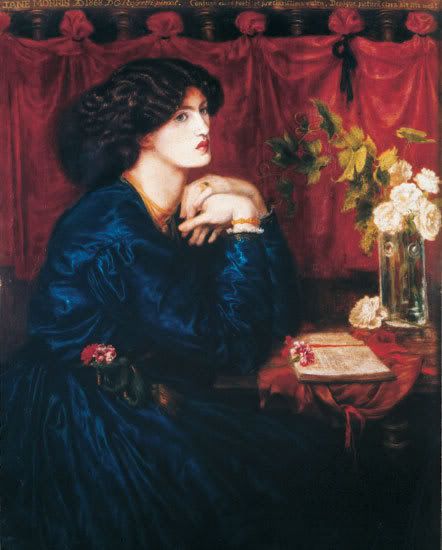
Thomas Carlyle once wrote that "society is founded on clothes" and it seems that most social reformers throughout history have agreed. From the long hair sported by hippies in the swinging 60s to the indie fashions of today, clothing has always played a major role in protest. Not surprisingly, clothing also played a leading role in the Pre-Raphaelites vision for a better society. The fashion trend known as "artistic dress" which was popularized by the Pre-Raphaelite models was one of the movement's main legacies.
The movement towards artistic dress can be found in the Pre-Raphaelite's paintings and literature. In Morris' Utopian novel News from Nowhere, the working people are freed from the exploitation of greedy capitalists. One of the first things they do with their freedom is to create beautiful things, including clothing. Their dress is characterised by bright colours, embroidery and handcrafted buckles. The women of Nowhere are "clothed like women, not upholstered like arm-chairs"(53). Because their clothing is not as restrictive, the are able to participated in activities like rowing boats and making hay.
As with their notions about art and architecture, the Pre-Raphaelties weren't content to let their ideas about clothing remain in the art scene. Artistic dress soon became wildly popular in the real world as actresses and other women connected to the art world began imitating the styles sported by Jane Morris and the other Pre-Raphaelite models, such as Lizzie Siddal.
Artistic dress was a reform movement, and was sometimes referred to as "Dress Reform" or the "Rational Dress Movement." Dress reformers were particularly concerned with the restrictiveness of Victorian-era undergarments (especially the corset). As you can see from this painting of Jane Morris, her dresses did not have the extreme "wasp" or "S" shape that was all the rage at the time, and instead featured a more natural silhouette.
As the popularity of artistic dress grew, companies began offering styles that catered to the new trend. Arthur Lasenby Liberty's department store soon became a mecca for followers of the fashion of aesthetic or artistic dress. Liberty specialized in fabrics that appealed to fans of Pre-Raphaelite style and even sold ready-made "artistic" fashions.
Tuesday, April 1, 2008
Jane Morris and Artistic Dress
Posted by
Margaret
at
8:38 AM
![]()
![]()
Labels: fashion, jane morris, pre-raphaelites
Subscribe to:
Post Comments (Atom)


1 comment:
This was beautiful written. There are so many things I'm thinking and would like to say. Clothing has always been used to make a class separation. I have always hated that about fashion. In the perfect society beautiful quality clothing would be accessible to all.
Nancy
Post a Comment